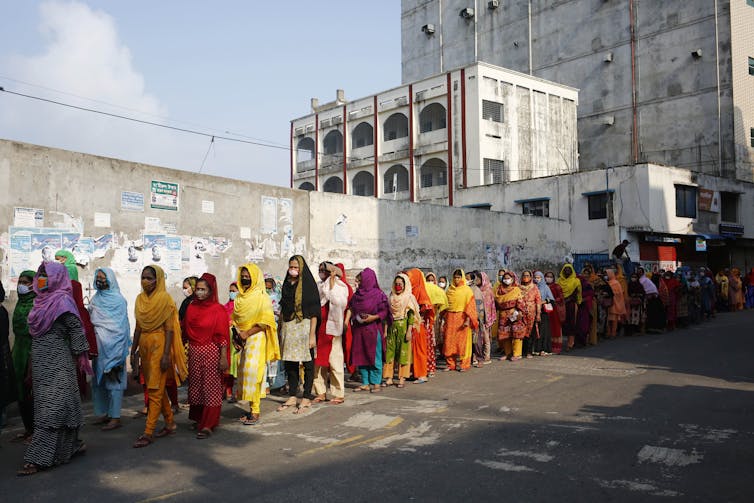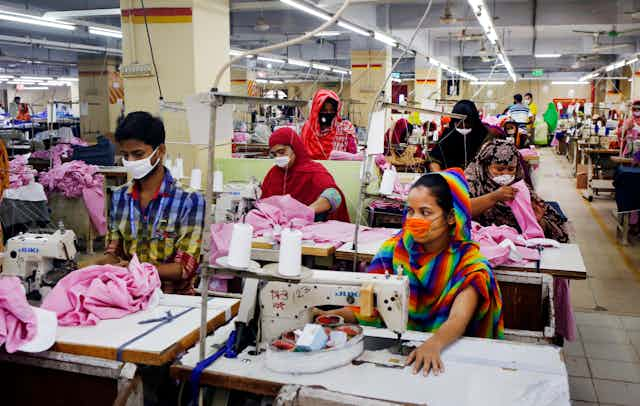Over the past three decades, global inequality has reached a critical level. The world’s 26 richest people own as much as poorest 50%. Multinational fashion companies have secured billions of dollars by moving production locations abroad and using supply chains in developing countries including Bangladesh, China, India, and Myanmar, where labour costs are very low.
The revenues of each of the 25 biggest companies are larger than the GDPs of some countries. Despite this, the lives of most of the workers involved in production for many of these companies have not improved. It takes a CEO from a big fashion, retail or other company just four days to earn the same amount a Bangladeshi garment worker will earn over her lifetime.
Many have described the conditions of such workers as modern slavery. Their plight is particularly clear during the current coronavirus pandemic – workers have either been laid off without pay, or forced to work in unsafe environments.
Read more: Fashion production is modern slavery: 5 things you can do to help now
Over the past 15 years, I have been investigating corporate accountability in relation to the lives of those who work in garment factories for western buyers. Colleagues and I recently published research deriving from interviews with workers’ rights NGOs, social auditors appointed by multinational companies and those owning and working in garment factories in Bangladesh that supply goods to big multinational companies including Walmart, H&M, Zara, Marks & Spencer, Primark, Loblaws, Target, Carrefour, Bestseller, Sainsbury’s, Reebok, Kmart and Coles.
We found that despite all the social audits, social responsibility disclosures and moral narratives that companies use, workers’ economic and human rights have not improved, while companies’ revenues balloon and factory owners get rich.
Factories in Bangladesh are the second largest garments producers in the world after China, with the sector accounting for 80% of the country’s total export earnings. Many individual factory owners have become ultra-rich as a result.

Deepening inequality
One local workers’ rights NGO, interviewed for our research, told us that a decade ago, most factory owners didn’t own cars. But he described how over the course of the last ten years one factory owner he knew had acquired four luxury cars, five houses, and five new factories. “He becomes one of the richest people in this society”, we were told:
Now compare this with a hard-working worker who started working ten years back. What change can you observe? Nothing has changed in her livelihood.
In 2018, amid international pressure in the aftermath of the Rana Plaza disaster, Bangladesh’s government raised the minimum wage for garment workers. But these are still the extremely low, far below the living wage. Pro-worker NGOs and civil rights organisations are vocal about the massive exploitation, slavery and human rights negligence within the industry.
Despite this, factory owners and industry leaders are not happy about growing concern over minimum wages. Many baulk at the idea that the cost of production could become any higher. One factory owner we interviewed, who is also an industry association leader, told us:
If there is a stringent regulation that leads to costs of production being higher, MNCs [multinational corporations] leave for another country where they can find cheaper products. Our suppliers in Bangladesh are getting more offers than ever before as MNCs are leaving China, as its cost of production is getting higher because of Chinese living standards. So, if somehow the cost of production is higher, the reality is that manufacturers will lose contracts soon, as there is no long-term commitment by MNCs. So, government needs to set up a regulation that should create a win–win situation. If we see our industry becomes a potential loser from the potential regulation, we shouldn’t let that happen for our national interest.
This factory owner reasons against any increase in production costs by indicating that profit maximisation protects national economic interests. To this owner, more profit means more export earnings, more foreign reserves for the country, and a more stable economy. But this seems to go hand in hand with risking workers’ basic economic and human rights. In Bangladesh, the idea that national economic interest is at stake appears to be more of a concern than the protection of workers’ rights.
This is perhaps unsurprising, as the garment industry has also changed Bangladesh’s political system. Businessmen are increasingly finding roles in parliament. After Bangladesh gained independence from Pakistan in 1971, 13% of MPs in the country’s first parliament (1973) were businessmen. By 2014, this had risen to 59% by 2014 and to 61.07% in 2018.
The massive participation of businessmen in the past two elections – both of which have been criticised over boycotts and allegations of vote rigging – has given the country a new shape.
Factories and coronavirus
In 2020, this has come to a head. The export-oriented garment industry in Bangladesh comprises more than 4,000 factories and five million workers, the majority of whom are women. The industry earns approximately US$35 billion (£28 billion) each year by supplying garments to western companies. While such trade has already boosted the huge economic power of factory owners, the coronavirus pandemic is leaving workers in a much more vulnerable position than factory owners.
Read more: How Asia's clothing factories switched to making PPE – but sweatshop problems live on
Western multinational companies have started cancelling orders, some reportedly without paying for production costs already laid out. Million of workers are facing destitution having been sent home without pay. As of April, more than US$3 billion in orders to around 1,150 factories were in limbo, leaving around 2.8 million workers, mostly women, facing poverty and hunger.

In order to complete those orders not yet cancelled, some owners kept factories open through lockdown without scope for proper social distancing. Restrictions for factories were then relaxed in May despite the increasing number of coronavirus cases in Bangladesh. Understandably, many fear that more and more workers will get infected in the factories.
Some of the big companies are now delaying payments and asking for discounts from factories – with potentially catastrophic consequences for the women who make their clothes. Neither government nor factory owners – nor even the multinational companies – are taking clear and solid responsibility for workers who were sacked or lost their jobs from factories.
Many of them, and their families, will go hungry.

